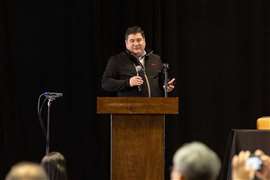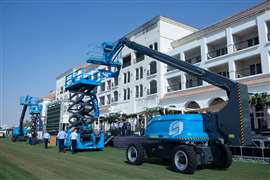Moving history
25 April 2008

The new Mercedes-Benz museum in Stuttgart is filled with cars, buses, trucks and engines from the German company's 120 year history. Attractions include a selection of historic racing cars set on a steep curved track, a car transporter loaded with various Mercedes saloons and vintage aircraft fitted with Daimler engines. There are also original examples of the first powered Mercedes vehicles from the late 19th Century, specimens that it would be impossible to put a price tag on.
The museum was designed by Dutch architect Ben van Berkel and was described by a director of Mercedes-Benz Heritage as “perfect as a museum, but a nightmare in terms of heavy exhibits – we would rather display stamps in there”
The architecture of the building is a helix design that links various levels within the outer shell. Scholpp was responsible for installing exhibits on three of the levels; the self explanatory Legend and Collection exhibits and the Fascination Technique, where experimental and concept cars from Mercedes' history were to be on show.
In addition to the wide selection of commercial, sporting and experimental cars to be installed in the museum, there were trucks, buses and car transporters, all of which had to enter the museum at street level. There were also guidelines imposed by Daimler Chrysler (owner of Mercedes-Benz and the museum), as well as limitations on the equipment that could be used inside the museum. Some of these stipulations included the signing off of all lifting and transportation plans by a civil engineer, white non marking tyres on all lifting and transport machinery, a dead man's switch on all equipment to avoid uncontrolled movement on all powered vehicles and, most importantly, no exhaust fumes could be produced by the lifting and transport equipment.
Once these parameters had been met, Scholpp was faced with another challenge – to meet the strict weight guidelines laid down by the museum's owner. Maximum floor load throughout the museum was restricted to 350 kg/m2.
To bring the attractions into the museum at street level, Scholpp used a variety of lifting devices, including a hydraulic scissorlift, a lift basket powered by electric winches and an under bucket air film transport system.
Once inside, the company used its Octopus crane for many of the installations. The Octopus, built by Scholpp in 2003, is an HMF knuckle boom loader crane mounted on a compact chassis. It is powered either by a diesel engine or battery, which made it compatible with Daimler Chrysler's rules concerning the types of equipment that could be used in the museum. It was also designed to fit in an industrial elevator and operate in cramped conditions, making it particularly suitable for this job.
To install some of the Mercedes racing cars onto a track with a 60° inclination, Scholpp used a Lift Systems TG 95 hydraulic gantry to lower the cars onto the track.
Another challenge was loading a range of SEC saloon models onto a car transporter. An extra small gantry was the solution and the cars that were to be placed on the upper deck of the transporter were lifted and then rolled into place. Clearance between the roofs of the cars and the museum ceiling was 20mm.
Outside the building, a mobile crane from Scholpp's fleet was called in to place a statue of legendary racing driver Juan Manuel Fangio and the Mercedes-Benz W196 Monoposto that he drove and dominated Formula One in 1955, the only year it ever raced.






